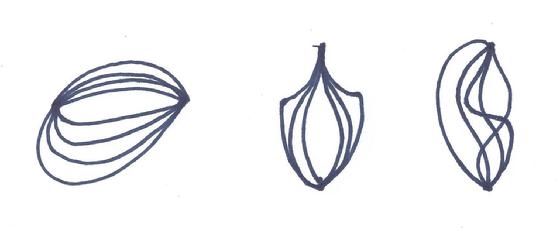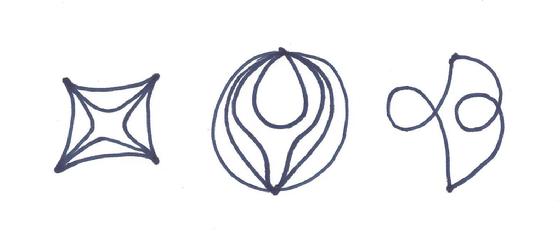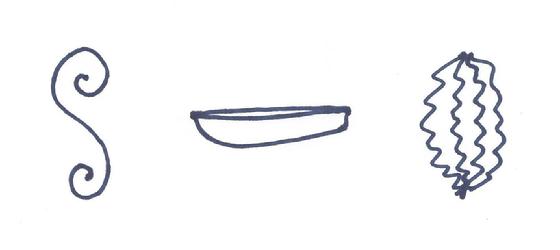Pull, Bend, and Push, Marks
By Feel
Keep in mind that thinking in principle, these Quick Sketch warm ups, exercises, and lessons apply with advantage to all other interests!
|
|
Quickly revisit warm-up number one. With this next warm up we will integrate another intention with clear intent and develop a feel for endless variations of curved lines. Integration means we will continue what we learned to do in the first warm-up and expand and interrelate that intention with another one.
|
 |
| Bending Lines |
|
|
|
First, starting with establishing intent, draw a line to your established destination. Then as a warm-up, push and pull further attempts between the start and stop. This results in curved lines achieved entirely by feel of the motion and visual feedback as we work. By varying how much you push or pull you can adjust how much or how little curvature results. By varying where you adjust the curve you can get a radius with very even adjustment or any curve imaginable with placement of the variation of pull or push. With a lot of exploration a feel for symmetry may be developed.
|
 |
| Exploring Variation of Intention |
|
|
|
The ‘Art of Questioning’ is one of the most fruitful toolboxes for creativity. How many questions about alternatives are there? How many variations can be invented for answers to each question? A general principle for use in the creative process is to avoid closure. When no further ideas emerge easily or time is short, leave the questions open in your subconscious by not assuming ‘That’s all,’ or ‘I can’t think of any more.’ Establish the intent of returning to the Questions for more persistent exploration at some later time. What about the feel of lines used in cursive handwriting that are already on automatic? Examples; what about loops altered in direction, combined intentions, size variation, retracing parts of lines, multiple sets of intentions, use of design criteria as in font design, etc.
|
 |
| Feel with Utilitarian Intent |
|
|
|
How can these warm-ups and lessons be applied to something useful for visual purpose? Utility is one of the first questions that usually comes up and is a great motivator for individuals raised in modern cultures. Creativity and innovation are at cross purposes in many ways. The criteria of utility eliminates the vast majority of creative possibilities in part in the way it is used and in part because it is used too soon. The big creativity killer is failure to integrate the two intentions. When they are not seen as different innovation will dominate. The usual cultural habit when they are seen as different is to separate the processes, place them in opposition and choose one or the other. They are more rewarding when used as an interactive mental process akin to open teamwork.
|
This is not multitasking! Integration is using your ability to operate using multiple criteria applied to the same intention. This is accomplished by placing each element/operation on automatic controlled mostly from the subconscious as a habit. Multitasking is attempting to do more than one separate thing at a time directed by the conscious mind. Projects are kept separate in the mind and attention jumps around trying to juggle everything without 'dropping a ball. ‘Your conscious mind is not set up to focus on more than one or a very few things at a time. The subconscious, on the other hand can accumulate a great number of flexible habits and integrate them toward one or more intentions and adjust motor coordination to perceptual feedback accordingly. This is how athletes, artists, and others develop complex working operations to a high degree.
I am introducing the basic' Byler Ratchet' here to show how to integrate multiple skills rather than learning them separately then trying to integrate them every time a new combination is needed. Integration is accomplished by focusing on a simple basic element of the complex intention until a feel starts to develop comfortably. The idea is not to repeat it in an identical way until it becomes a rote rigid habit. Placing many things on automatic frees up your conscious mind to do what it is actually good at, like analysis, planning, strategy, some aspects of critique, and much more.
As the feel each element or operation becomes somewhat comfortable, a new element is taken on as the current focus while maintaining the previous elements. This allows each to learn to work smoothly with the others as they are accumulated. They are integrated by focusing on the new element which automatically places previous elements in the subconscious as a flexible habit. The flexibility results from adjusting to the new intent that is being focused on. As long as you integrate learning new habits with the old continuously they will remain flexible and adjust to whatever intention they are applied to.
Each new learning focus is new to the integration habits and will somewhat disrupt the 'flow' that is being established. Don't worry, this doesn't mean it isn't working. In fact if it doesn't happen at least a little bit it means integration isn't occurring. When there is no discomfort the new learning is just stacking separately like adding books separately to a stack. Expect slight setbacks or plateaus. New integration will initially challenge your confidence but ultimately expand your comfort level. It is part of the integration process. Look forward to working through it knowing that as everything begins to work together Integration is occurring and slipping into the subconscious for application to whatever vision is developing and whatever specific idea needs these abilities.
|
|
|